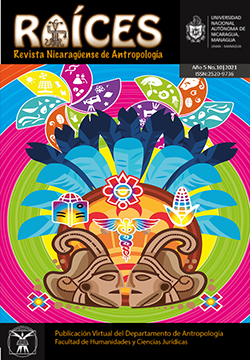Direct experience with the embodied expressions of krsna’s devotion: moments of crisis in the anthropological labor
DOI:
https://doi.org/10.5377/raices.v5i10.13604Keywords:
Researcher, āśrāma, impure, experience, womanAbstract
During fieldwork, the social investigator looks for objectivity in social facts, observing, participating in activities, listening and taking notes, looking for elements to knit the conceptual framework with the reality observed. Nevertheless, from my own experience, each fieldwork that I had been involved with, has produced concerns, emotions and a constant challenge between my value judgments and my own subjectivity interposed with the investigation. That is why in this article I share the experience of having performed an extended stay in an āśrāma of the Hare Krsna religious community of Mexico City, which involved a corporealization of devotional practices based on the sex that invests my body, regulating my behaviors through the subjectivation of the sacred symbols established by the religious group, making my body got ill, symbolizing for the community a detoxification and purifying, and for me, a fight between my subjectivity, my emotions and the reality of the fieldwork, signifying a watershed in research around the religious group.
Downloads
References
Citro, S. (2011). “Cuando escribimos y bailamos. Genealogías y propuestar teoríco-metodológicas para una antropología de y desde las danzas”. En P. A. Silvia Citro, & C. Culturalia (Ed.), Cuerpo en movimiento antropología de y desde las danzas. Buenos Aires : Editorial Biblos.
Esteban, M. L. (2008). “Etnografía, itinerarios corporales y cambio social. Apuntes teóricos y metodológicos”. En M. E. (coord.), La materialidad de la identidad. España: Hariadna Editoriala.
Geertz, C. (2003). La interpretación de las culturas. Barcelona: Gedisa.
Gómez, Z. P. (2006). “Modernidad y orden simbólico: cuerpo y biopolítica en América Latina”. 5(9). Colombia. Obtenido de http://ccultural.ut.edu.co/images/Revistas%20Aquelarre/Aquelarre%2009.pdf
Guber, R. (2011). La etnografía: Método, campo y reflexividad. Argentina: Siglo Veintiuno Editores
Mauss, M. (1979). Sociología y Antropología. Madrid: Tecnos.
Trust, B. B. (s.f.). Cancionero del Templo . The Bhaktivedanta Book Trust International .
Vallverdú, J. (1999). “Conversión, compromiso y construcción de identidad en el movimiento Hare
Downloads
Published
How to Cite
Issue
Section
License
Copyright (c) 2021 Universidad Nacional Autónoma de Nicaragua. UNAN-Managua, Nicaragua.

This work is licensed under a Creative Commons Attribution-NonCommercial-ShareAlike 4.0 International License.




